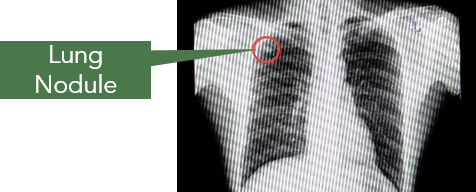Is it Common to have Lung Nodules?
Lung nodules are very common. Approximately one in four (25%) older patients who smoke or have previously smoked have nodules that can be detected via computed tomography (CT) scans.
Lung nodules may also occur in people who do not smoke.
Why do Lung Nodules Occur?
Most lung nodules are benign (non-cancerous) and are the result of scarring or previous infections such as tuberculosis. However, in some patients, the nodule could be lung cancer or cancer which has spread from elsewhere in the body.
Do Lung Nodules Cause Any Symptoms?
Lung nodules rarely cause any symptoms. They are too small to cause pain or breathing problems. However, please inform your doctor if you experience any symptoms.
How are Lung Nodules Diagnosed?
Lung nodules are commonly seen on CT scans performed for other reasons. Sometimes, they can be detected on chest radiographs if they are larger in size.

It is not always possible to determine the cause of the lung nodules from CT scans alone. Biopsy, a procedure to obtain small samples from the nodule for further evaluation, may not be successful if the nodule is too small in size.
What Happens After Lung Nodules are Found?
For nodules that are small, CT scans are carried out to keep a close eye on them. If they are tiny, follow-up appointments may not be required because the chances of it being cancer is low. Your doctor will discuss with you on the recommended follow-ups required based on your medical condition, preferences and international guidelines.
Generally, if the nodules do not grow over a two-year period, it is less likely to be cancer. However, some lung nodules which appear ‘ground-glass’ (looks like a hazy area on a CT scan) may require longer monitoring for at least five years.
During your lung nodule follow-ups, a low dose radiation CT technique is commonly used to reduce radiation exposure.
For larger nodules or ones that are growing, your doctor may discuss further test options with you. This includes:
CT Scan-guided Biopsy
CT imaging is used to guide a needle through the chest wall and into the lung to take small tissue samples from the lung nodule to be examined for abnormal cells.
Bronchoscopy
While sedated with medications to make you feel sleepy, a thin tube with a camera is passed through your throat and airways to retrieve small tissue samples from the lung nodule.
To improve the accuracy in reaching the nodule, your doctor may use additional tools including ultrasound and Electromagnetic Navigation Bronchoscopy (ENB). ENB uses your CT scan to create a map to guide your doctor through the airways towards the nodules that are not easily reached by traditional bronchoscopy.
Position Emission Tomography (PET) Scan
PET scans use radioactive sugar which is taken up by cancer cells. This may provide additional information to make a decision for a biopsy.
Surgery
If there is a high chance of the nodule being cancer, or if it cannot be reached by needle or bronchoscopy, surgery may be performed to remove the lung nodule.
How Can I Prevent Lung Nodules?
Unfortunately, not much can be done to prevent lung nodules from developing as they may still occur due to scarring or from past infections.
However, if you smoke, quitting is the best way to reduce the risk of lung-related illnesses including lung cancer. You may speak to your doctor to find out more about Smoking Cessation Services available in the hospital.
What if My Lung Nodule is Cancer?
Generally, a lung nodule which is diagnosed to be cancerous may be an early stage of lung cancer. Your doctor will perform further scans to confirm this, following which, treatments such as surgery or radiation therapy can be considered.
